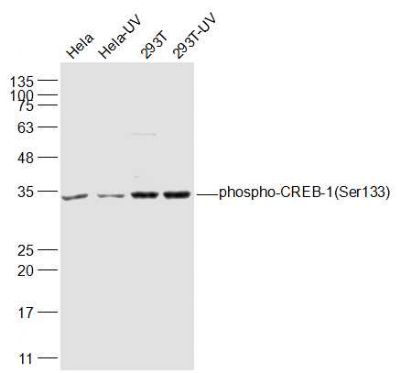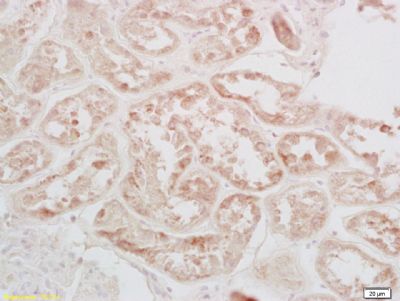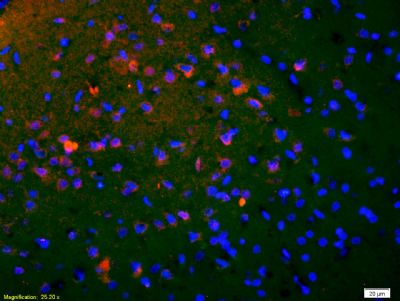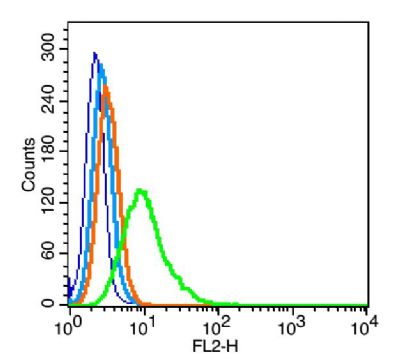产品中心
当前位置:首页>产品中心Anti-phospho-CREB-1(Ser133)
货号: bs-0036R 基本售价: 1580.0 元 规格: 100ul
产品信息
- 产品编号
- bs-0036R
- 英文名称
- phospho-CREB-1 (Ser133)
- 中文名称
- 磷酸化CREB-1抗体
- 别 名
- CREB(Phospho-Ser133); p-CREB-1(Ser133); CREB (phospho S133); pCREB-1(Ser133); p-CREB (phospho S133); Active transcription factor CREB; cAMP response element binding protein; cAMP responsive element binding protein 1; CREB1; CREB 1; CREB1; MGC9284; Transactivator protein; CREB; CREB1_HUMAN.
- 规格价格
- 100ul/1580元购买 大包装/询价
- 说 明 书
- 100ul
- 产品类型
- 磷酸化抗体
- 研究领域
- 免疫学 染色质和核信号 信号转导 转录调节因子
- 抗体来源
- Rabbit
- 克隆类型
- Polyclonal
- 交叉反应
- Human, Mouse, Rat, Chicken, Dog, Pig, Cow, Sheep,
- 产品应用
- WB=1:500-2000 ELISA=1:500-1000 IHC-P=1:400-800 IHC-F=1:400-800 Flow-Cyt=1μg/Test IF=1:100-500 (石蜡切片需做抗原修复)
not yet tested in other applications.
optimal dilutions/concentrations should be determined by the end user.
- 分 子 量
- 37kDa
- 细胞定位
- 细胞核
- 性 状
- Lyophilized or Liquid
- 浓 度
- 1mg/ml
- 免 疫 原
- KLH conjugated Synthesised phosphopeptide derived from human CREB-1 around the phosphorylation site of Ser133:RP(p-S)YR
- 亚 型
- IgG
- 纯化方法
- affinity purified by Protein A
- 储 存 液
- 0.01M TBS(pH7.4) with 1% BSA, 0.03% Proclin300 and 50% Glycerol.
- 保存条件
- Store at -20 °C for one year. Avoid repeated freeze/thaw cycles. The lyophilized antibody is stable at room temperature for at least one month and for greater than a year when kept at -20°C. When reconstituted in sterile pH 7.4 0.01M PBS or diluent of antibody the antibody is stable for at least two weeks at 2-4 °C.
- PubMed
- PubMed
- 产品介绍
- background:
The ATF/CREB family consists of transcription factors that function through binding to the cAMP responsive element (CRE) palindromic octanucleotide, TGACCTCA. The best characterized members of this gene family include CREB-1, CREB-2, ATF-1,ATF-2,ATF-3and ATF-4. these transcription factors share highly-related COOH terminal leucine zipper demerization and basic DNA bindings but are highly divergent in their amino terminal domains. Although each of the ATF/CREB proteins bind CREs in their homodimeric form, in cerain instances they also bind as heterodimers, both within the ATF/CREB family and with members of the AP-1 transcription factor family. It has recentlybeen shown that protein kinase A-mediated CREB phosphorylation results in its binding to a 265kDa nuclear protein designated CBP (CREB-binding protein), which may reprecent a CREB co-activator.
Function:
Phosphorylation-dependent transcription factor that stimulates transcription upon binding to the DNA cAMP response element (CRE), a sequence present in many viral and cellular promoters. Transcription activation is enhanced by the TORC coactivators which act independently of Ser-133 phosphorylation. Involved in different cellular processes including the synchronization of circadian rhythmicity and the differentiation of adipose cells.independently of Ser-133 phosphorylation. Involved in different cellular processes including the synchronization of circadian rhythmicity and the differentiation of adipose cells. [SUBUNIT] Interacts with PPRC1. Binds DNA as a dimer. This dimer is stabilized by magnesium ions. Interacts, through the bZIP domain, with the coactivators TORC1/CRTC1, TORC2/CRTC2 and TORC3/CRTC3. When phosphorylated on Ser-133, binds CREBBP (By similarity). Interacts with CREBL2; regulates CREB1 phosphorylation, stability and transcriptional activity (By similarity). Interacts (phosphorylated form) with TOX3. Interacts with ARRB1. Binds to HIPK2. Interacts with SGK1.
Subunit:
Interacts with PPRC1. Binds DNA as a dimer. This dimer is stabilized by magnesium ions. Interacts, through the bZIP domain, with the coactivators TORC1/CRTC1, TORC2/CRTC2 and TORC3/CRTC3. When phosphorylated on Ser-133, binds CREBBP (By similarity). Interacts with CREBL2; regulates CREB1 phosphorylation, stability and transcriptional activity (By similarity). Interacts (phosphorylated form) with TOX3. Interacts with ARRB1. Binds to HIPK2. Interacts with SGK1.
Subcellular Location:
Nucleus.
Post-translational modifications:
Stimulated by phosphorylation. Phosphorylation of both Ser-133 and Ser-142 in the SCN regulates the activity of CREB and participates in circadian rhythm generation. Phosphorylation of Ser-133 allows CREBBP binding (By similarity). CREBL2 positively regulates phosphorylation at Ser-133 thereby stimulating CREB1 transcriptional activity (By similarity). Phosphorylated upon DNA damage, probably by ATM or ATR. Phosphorylated upon calcium influx by CaMK4 and CaMK2 on Ser-133. CaMK4 is much more potent than CaMK2 in activating CREB. Phosphorylated by CaMK2 on Ser-142. Phosphorylation of Ser-142 blocks CREB-mediated transcription even when Ser-133 is phosphorylated. Phosphorylated by CaMK1 (By similarity). Phosphorylation of Ser-271 by HIPK2 in response to genotoxic stress promotes CREB1 activity, facilitating the recruitment of the coactivator CBP. Phosphorylated at Ser-133 by RPS6KA3, RPS6KA4 and RPS6KA5 in response to mitogenic or stress stimuli.
Sumoylated with SUMO1. Sumoylation on Lys-304, but not on Lys-285, is required for nuclear localization of this protein. Sumoylation is enhanced under hypoxia, promoting nuclear localization and stabilization.
DISEASE:
Defects in CREB1 may be a cause of angiomatoid fibrous histiocytoma (AFH) [MIM:612160]. A distinct variant of malignant fibrous histiocytoma that typically occurs in children and adolescents and is manifest by nodular subcutaneous growth. Characteristic microscopic features include lobulated sheets of histiocyte-like cells intimately associated with areas of hemorrhage and cystic pseudovascular spaces, as well as a striking cuffing of inflammatory cells, mimicking a lymph node metastasis. Note=A chromosomal aberration involving CREB1 is found in a patient with angiomatoid fibrous histiocytoma. Translocation t(2;22)(q33;q12) with CREB1 generates a EWSR1/CREB1 fusion gene that is most common genetic abnormality in this tumor type.
Note=A CREB1 mutation has been found in a patient with multiple congenital anomalies consisting of agenesis of the corpus callosum, cerebellar hypoplasia, severe neonatal respiratory distress refractory to surfactant, thymus hypoplasia, and thyroid follicular hypoplasia (PubMed:22267179).
Similarity:
Belongs to the bZIP family.
Contains 1 bZIP domain.
Contains 1 KID (kinase-inducible) domain.
SWISS:
P16220
Gene ID:
1385
Database links:Entrez Gene: 281713 Cow
Entrez Gene: 1385 Human
Entrez Gene: 12912 Mouse
Entrez Gene: 81646 Rat
Omim: 123810 Human
SwissProt: P27925 Cow
SwissProt: P16220 Human
SwissProt: Q01147 Mouse
SwissProt: P15337 Rat
Unigene: 516646 Human
Unigene: 453295 Mouse
Unigene: 90061 Rat
Important Note:
This product as supplied is intended for research use only, not for use in human, therapeutic or diagnostic applications.
磷酸化环腺苷酸应答元件结合蛋白(p-cAMP responsive element binding protein-1, p-CREB-1)是真核细胞转录因子,属于ATF/CREB家族。参与由cAMP或某些病毒蛋白质所诱导基因转录的调节。
- 产品图片
 Sample:
Sample:
Hela(Human) Cell Lysate at 30 ug
Hela-UV(Human) Cell Lysate at 30 ug
293T(Human) Cell Lysate at 30 ug
293T-UV(Human) Cell Lysate at 30 ug
Primary: Anti-phospho-CREB-1(Ser133) (bs-0036R) at 1/1000 dilution
Secondary: IRDye800CW Goat Anti-Rabbit IgG at 1/20000 dilution
Predicted band size: 337 kD
Observed band size: 35 kD Sample: U251 Cell lysate at 30 ug;
Sample: U251 Cell lysate at 30 ug;
Primary: Anti- phospho-CREB-1(Ser133) (bs-0036R) at 1:300 dilution;
Secondary: IRDye800CW Goat Anti-Rabbit IgG at 1/20000 dilution
Predicted band size:35kD
Observed band size:37kD Tissue/cell:bs-0036R human kidney tissue; 4% Paraformaldehyde-fixed and paraffin-embedded;
Tissue/cell:bs-0036R human kidney tissue; 4% Paraformaldehyde-fixed and paraffin-embedded;
Antigen retrieval: citrate buffer ( 0.01M, pH 6.0 ), Boiling bathing for 15min; Block endogenous peroxidase by 3% Hydrogen peroxide for 30min; Blocking buffer (normal goat serum,C-0005) at 37℃ for 20 min;
Incubation: Anti-phospho-CREB-1(Ser133) Polyclonal Antibody, Unconjugated(bs-0036R) 1:200, overnight at 4°C, followed by conjugation to the secondary antibody(SP-0023) and DAB(C-0010) staining Tissue/cell: rat brain tissue;4% Paraformaldehyde-fixed and paraffin-embedded;
Tissue/cell: rat brain tissue;4% Paraformaldehyde-fixed and paraffin-embedded;
Antigen retrieval: citrate buffer ( 0.01M, pH 6.0 ), Boiling bathing for 15min; Blocking buffer (normal goat serum,C-0005) at 37℃ for 20 min;
Incubation: Anti-phospho-CREB-1(Ser133) Polyclonal Antibody, Unconjugated(bs-0036R) 1:200, overnight at 4°C; The secondary antibody was Goat Anti-Rabbit IgG, Cy3 conjugated (bs-0295G-Cy3)used at 1:200 dilution for 40 minutes at 37°C. DAPI(5ug/ml,blue,C-0033) was used to stain the cell nuclei Blank control: RSC96(blue), the cells were fixed with 2% paraformaldehyde (10 min) and then permeabilized with ice-cold 90% methanol for 30 min on ice.
Blank control: RSC96(blue), the cells were fixed with 2% paraformaldehyde (10 min) and then permeabilized with ice-cold 90% methanol for 30 min on ice.
Isotype Control Antibody: Rabbit IgG(orange) ; Secondary Antibody: Goat anti-rabbit IgG-PE(white blue), Dilution: 1:200 in 1 X PBS containing 0.5% BSA ; Primary Antibody Dilution: 1μg in 100 μL1X PBS containing 0.5% BSA(green).

